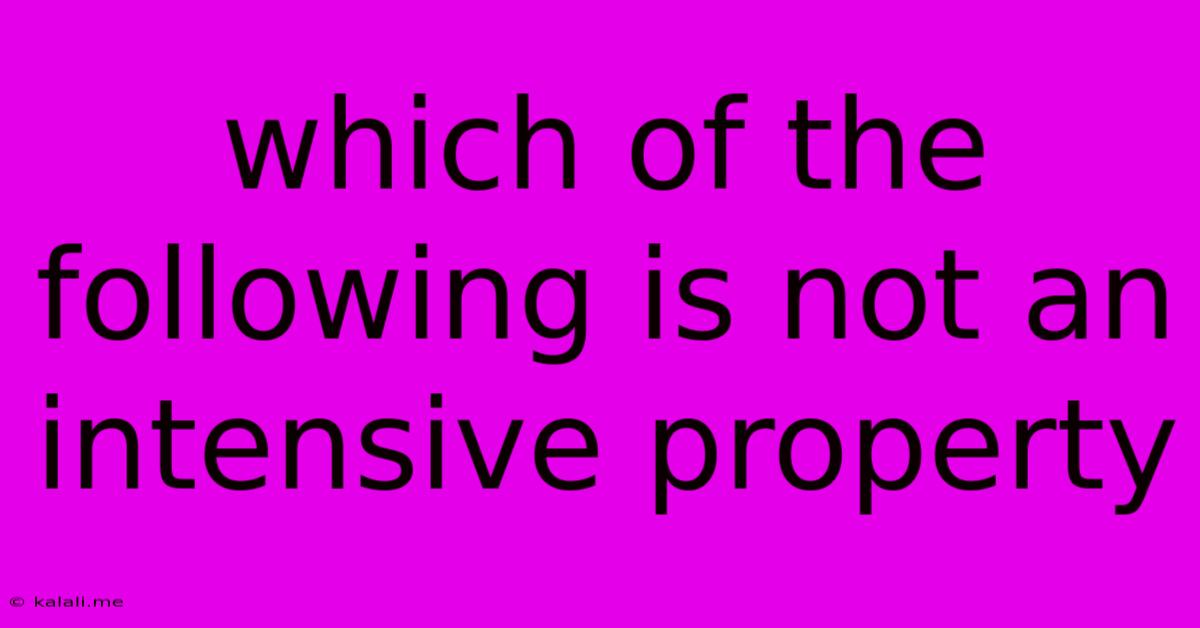Which Of The Following Is Not An Intensive Property
Kalali
Jun 14, 2025 · 3 min read

Table of Contents
Which of the Following is NOT an Intensive Property? Understanding Intensive vs. Extensive Properties
This article will delve into the difference between intensive and extensive properties of matter, clarifying which properties depend on the amount of substance and which don't. We'll explore several examples, ultimately answering the question: which of the following is NOT an intensive property? This is a crucial concept in chemistry and physics, often appearing in introductory science courses and beyond.
What are Intensive and Extensive Properties?
Before we identify which property isn't intensive, let's define the terms:
-
Intensive Properties: These properties are independent of the amount of substance present. They describe the inherent nature of the substance itself. Think of it this way: no matter how much you have of the substance, the intensive property will remain the same.
-
Extensive Properties: These properties depend on the amount of substance present. If you increase the amount of substance, the extensive property also increases proportionally.
Examples of Intensive Properties:
- Temperature: Whether you have a single drop or a liter of water at 25°C, the temperature remains 25°C.
- Density: The density of gold is always the same, regardless of whether you have a gold nugget or a gold bar (assuming the same purity).
- Melting Point: The melting point of ice is always 0°C (at standard pressure), irrespective of the ice cube's size.
- Boiling Point: Similar to melting point, the boiling point of a substance is an intensive property.
- Color: The color of a substance doesn't change with the amount present.
- Pressure: The pressure exerted by a gas, in a closed container, is independent of its quantity.
- Refractive Index: This optical property remains constant regardless of sample size.
- Hardness: The hardness of a diamond is the same whether it's a tiny speck or a large gemstone.
Examples of Extensive Properties:
- Mass: The mass of a substance increases linearly with the amount of substance.
- Volume: The more substance you have, the greater the volume it occupies.
- Length: The length of a wire, for example, depends on the amount of material used.
- Heat Capacity: The ability of a substance to absorb heat is directly related to its mass.
- Energy: The total energy content of a system depends on the size or quantity of the system.
Identifying the Non-Intensive Property
Now, let's imagine a multiple-choice question presenting several properties. To correctly identify the property that's not intensive, you need to ask yourself: does this property change if I increase the amount of the substance? If the answer is yes, then it's an extensive property, and therefore not an intensive property.
For instance, if the choices were: temperature, volume, density, and color, the answer would be volume. Volume is directly proportional to the amount of substance; doubling the amount of substance doubles the volume. The others remain unchanged regardless of the amount.
Understanding the difference between intensive and extensive properties is fundamental to various scientific disciplines, enabling us to describe and analyze matter effectively. By grasping this concept, you can more readily solve problems involving the physical and chemical characteristics of substances.
Latest Posts
Latest Posts
-
Modulus Of Elasticity Of Steel In Mpa
Jun 15, 2025
-
A Switch Is Used In A Circuit To
Jun 15, 2025
-
How To Get Sat Admission Ticket
Jun 15, 2025
-
What Is The Difference Between Perpetuity And Annuity
Jun 15, 2025
-
Select Each Of The True Statements About Dna Structure
Jun 15, 2025
Related Post
Thank you for visiting our website which covers about Which Of The Following Is Not An Intensive Property . We hope the information provided has been useful to you. Feel free to contact us if you have any questions or need further assistance. See you next time and don't miss to bookmark.